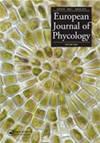Export flux succession of dinoflagellate cysts and planktonic foraminifera in an active upwelling cell off Cape Blanc (NW Africa)
IF 1.7
4区 生物学
Q2 MARINE & FRESHWATER BIOLOGY
引用次数: 2
Abstract
Abstract To better understand production, succession, excystment and transport of dinoflagellate cysts (dinocysts) and planktonic foraminifera in the upper water column, we investigated their fluxes during a 7-day survey in the active upwelling off Cape Blanc (NW Africa) in November 2018 with drifting traps at 100 m, 200 m and 400 m water depth. The survey covered a change from active upwelling to stratified conditions. Highest production of organic dinocysts and planktonic foraminifera was observed during active upwelling conditions and decreased drastically towards the end of the survey. Calcareous dinocysts appeared later during upwelling relaxation. Cytoplasm-bearing (full) dinocysts and foraminifera were produced in the water column above the traps (<100 m depth). Some of the empty dinocysts were resuspended, implying that sediments below the survey site contain both local and allochthonous cyst assemblages. This is the first demonstration that excystment in the upper water column is species-specific. Brigantedinium excysted in the upper water column before reaching deeper depths, whereas no upper water column excystment was observed for the other dinoflagellate species. Dinoflagellate and planktonic foraminifera associations showed a clear succession. During active upwelling, Echinidinium zonneveldiae, Brigantedinium spp., other peridinioids, Echinidinium spp., cysts of Pentapharsodinium dalei, ‘other photosynthetic organic-walled dinocysts‘, Neogloboquadrina incompta and Globigerinella calida were collected. During upwelling relaxation, Lingulodinium machaerophorum was produced; and under stratified conditions Gymnodiniaceae cysts (G. microreticulatum, G. catenatum) and the foraminifera Globigerina bulloides and Orbulina universa were sampled. Apart from enhancing knowledge of these species, our observations allow more detailed reconstructions of upwelling history in the Cape Blanc region based on sedimentary archives using fossilized dinoflagellate and planktonic foraminifera assemblages.在勃朗角一个活跃的上升流细胞中鞭毛藻囊和浮游有孔虫的输出通量演替(西北非洲)
摘要为了更好地了解上层水柱中甲藻囊肿(甲藻囊肿)和浮游有孔虫的产生、演替、排泄和运输,我们于2018年11月在布兰科角(非洲西北部)附近的活跃上升流中进行了为期7天的调查,并在100米、200米和400米水深处设置了漂移陷阱。调查涵盖了从活跃上升流到分层条件的变化。在活跃的上升流条件下观察到有机恐龙囊肿和浮游有孔虫的产量最高,并在调查结束时急剧下降。钙质恐龙囊肿在上升流松弛过程中出现较晚。在捕集器上方(深度<100 m)的水柱中产生了带有细胞质(完整)的恐龙囊肿和有孔虫。一些空的恐龙囊肿被重新悬浮,这意味着调查地点下方的沉积物包含本地和外来的囊肿组合。这是首次证明上层水柱中的排泄物具有物种特异性。Brigantedinium在到达更深的深度之前在上层水柱中排出,而其他甲藻物种没有观察到上层水柱排出。甲藻和浮游有孔虫组合显示出明显的连续性。在活跃的上升流过程中,收集到了总氏棘皮藻、Brigantedinium spp.、其他周类、棘皮藻spp.、大丽五头藻的包囊、“其他光合有机壁的包囊”、新球状四足虫和杯形Globigerinella calida。在上升流弛豫过程中,产生了马齿藻;并在分层条件下对Gymnodiniaceae囊肿(G.microreticulatum,G.catenatum)和大泡球虫有孔虫和普氏奥布利纳有孔虫进行了采样。除了增强对这些物种的了解外,我们的观测还允许根据沉积档案,使用甲藻化石和浮游有孔虫组合,更详细地重建布兰科角地区的上升流历史。
本文章由计算机程序翻译,如有差异,请以英文原文为准。
求助全文
约1分钟内获得全文
求助全文
来源期刊

European Journal of Phycology
生物-海洋与淡水生物学
CiteScore
4.80
自引率
4.20%
发文量
37
审稿时长
>12 weeks
期刊介绍:
The European Journal of Phycology is an important focus for the activities of algal researchers all over the world. The Editors-in-Chief are assisted by an international team of Associate Editors who are experts in the following fields: macroalgal ecology, microalgal ecology, physiology and biochemistry, cell biology, molecular biology, macroalgal and microalgal systematics, applied phycology and biotechnology. The European Journal of Phycology publishes papers on all aspects of algae, including cyanobacteria. Articles may be in the form of primary research papers and reviews of topical subjects.
The journal publishes high quality research and is well cited, with a consistently good Impact Factor.
 求助内容:
求助内容: 应助结果提醒方式:
应助结果提醒方式:


